Volunteer Assistant Chief Killed When Struck by Tractor-Trailer While Operating at a Motor Vehicle Crash - North Carolina
 Death in the Line of Duty…A summary of a NIOSH fire fighter fatality investigation
Death in the Line of Duty…A summary of a NIOSH fire fighter fatality investigation
F2008-17 Date Released: December 15, 2008
SUMMARY
On June 14, 2008, a 51-year-old male volunteer Assistant Chief (the victim) was fatally injured after being struck by a tractor-trailer. The victim was assisting at a motor vehicle incident that had been caused by near-zero visibility conditions. Unforeseen weather conditions had caused smoke from a contained fire on a nearby military range along with fog to move across the four-lane highway. A truck driver attempting to slow his tractor-trailer down after encountering the smoke and fog swerved suddenly to miss a vehicle parked in the highway striking a Sheriff’s Deputy’s patrol car before striking and killing the victim. A Sheriff’s Deputy also lost his life and another was injured during this incident. Key contributing factors identified in this investigation include inability to establish traffic control on both sides of a divided highway, ineffective coordination of the multiple agencies involved in the emergency response, and unsafe vehicle operation of motorists during inclement weather and environmental conditions.
NIOSH investigators concluded that, in order to minimize the risk of similar occurrences, fire departments should:
- ensure that fire fighters responding to a scene involving a highway incident control oncoming traffic first, before responding to the emergency
- establish pre-incident traffic control plans and pre-incident agreements with law enforcement and other agencies such as highway departments
Additionally, Emergency Medical Services (EMS) should:
- ensure that emergency vehicles are parked in protected work areas when responding to emergency situations
Additionally, municipalities should consider:
- establishing a multi-agency communication system for response operations to coordinate and communicate incident activities
Although there is no evidence that the following recommendation could have specifically prevented this fatality, NIOSH investigators recommend that fire departments:
- ensure high-visibility vests meet minimum requirements of ANSI/ISEA 107-2004 or ANSI/ISEA 207-2006
INTRODUCTION
On June 14, 2008, a 51-year-old male volunteer Assistant Chief (the victim) was fatally injured after being struck by a tractor-trailer while assisting at a motor vehicle incident. On June 16, 2008, the U.S. Fire Administration (USFA) notified the National Institute for Occupational Safety and Health (NIOSH) of this incident. On June 23-27, 2008, a Safety and Occupational Health Specialist and General Engineer from the NIOSH Fire Fighter Fatality Investigation and Prevention Program traveled to North Carolina to investigate this incident. The NIOSH investigators met with the Fire Chief of the victim’s department, County Assistant Fire Marshal, County Sheriff, Military Base Fire Chief and Deputy Chief, EMS Supervisor, fire and EMS responders, and representatives of the North Carolina Occupational Safety and Health Administration (NCOSHA). The investigators reviewed the victim’s training records and witness statements, visited the incident site and took photographs. The investigators also reviewed the 911 dispatch logs, the North Carolina State Highway Patrol Crash Report, NCOSHA investigation photographs, fire photographs taken by the military base, Fire Marshal photographs of the incident, and the victim’s death certificate.
Fire Department
This volunteer fire department has one station with 23 volunteer members that serves a population of approximately 2,000 within an area of about 7 square miles. The department has two engines, a tanker, one tanker/pumper, and a brush truck.
County 911 Dispatch Center
Fire, EMS, and Sheriff’s Office each had their own designated console/area and dispatcher at the County 911 Dispatch center. The County 911 Dispatch center needed to be requested by a Fire, EMS, or Sheriff’s Office responder to patch the different bands together to enable users to communicate. A multi-agency agreement or memorandum of understanding had not been established between the agencies to automatically establish a common channel during a multi-agency response.
Training and Experience
The victim had served 33 years as a volunteer with this fire department and over 25 years as an officer. The victim had received his state Fire Fighter III certification, Hazardous Materials Level I certification, and he annually received 50 or more recertification hours in various fire service topics. The victim had also received training from the Institute of Transportation Research and Education and the North Carolina Department of Transportation (NCDOT) in flagger training, roadway spill response, and basic, intermediate, and advanced work zone safety.
The fire chief of the victim’s department established himself as the incident commander (IC). He has been a volunteer with this department for 34 years and a career fire fighter for 23 years at the neighboring military base. The fire chief holds numerous certifications and is a state of North Carolina fire instructor.
The fire department has written general operating guidelines (GOGs) regarding the use of personal protective equipment (PPE) during emergency and non-emergency incidents and operations at motor vehicle incidents. Theses GOGs focus on personal and incident safety, vehicle positioning, potential hazards, and traffic flow.
Road and Weather Conditions
The incident occurred in the northbound lanes of a four-lane coastal highway. This ¾ mile section of highway was straight and dry with a slight elevation approaching an overpass. The road surface was comprised of asphalt with a paved shoulder. A grass median separated the north and southbound lanes that are marked with a solid yellow and white line on the outer edges. The northbound lanes measured 24 feet wide with a dotted white center line. The shoulder was 12 feet wide. The road has a posted speed limit of 55 mph.
On the morning of the incident the temperature was 64°F and conditions were foggy with no wind (Photo 1). White smoke emitting from a contained fire had migrated south overnight to a low lying area on the highway, mixing with fog, and creating near zero visibility conditions. The white smoke was coming from a fire inadvertently started from the impacting of shells during a military training exercise. The military base training ground is located approximately ½ mile west and ½ mile north of the incident site. A spotter on a military fire tower had first noticed smoke coming from the training area on March 13, 2008. Three military brush units were initially dispatched with the forestry division to assess the fire. Forestry officials were unable to access this remote area with heavy machinery. A plowed fire line was placed around the 400 acre fire to contain it. The military fire department checked the fire daily to make sure the fire stayed contained, in hopes it would burn itself out. On May 20, 2008, a flare-up occurred due to dry conditions causing 200 additional acres to burn. A similar containment method was utilized to control the flare-up as the fire continued to smolder.
Personal Protective Equipment
At the time of the incident, the victim was wearing a full array of personal protective clothing and equipment, consisting of turnout gear (coat and pants), helmet, boots, and a high-visibility safety vest over his turnout coat. Both the vest and the turnout gear contained high-visibility reflective material. The vest was orange-red in color with a 1″ to 2″ wide fluorescent yellow vertical stripe over each shoulder connected to a 3″ to 5″ fluorescent yellow horizontal stripe with the word “F-I-R-E” in black letters across the front and back (Photo 2). The vest also contained cut-out sides and Velcro side breakaway points. The vest did not have 360 degrees of retroreflective material and it was not labeled as meeting ANSI/ISEA 107-2004 or ANSI/ISEA 207-2006a . The victim’s turnout gear had 3″ standard yellow-green/silver stripping. The turnout coat had two sets of stripes on each arm and a stripe around the coat bottom and mid chest. The bunker pants had a stripe at the bottom of each leg cuff. The victim carried a portable radio.
a In a graded exposure, the recruit or fire fighter could wear the mask in increasing increments in a safe environment. Flooding is where the recruit or fire fighter is exposed to their phobia at full intensity, such as in an IDLH atmosphere, for an extended amount of time.
Equipment and Personnel
The timeline for this incident listed in order of arrival time and key events, includes:
0433 hours
- County 911 Dispatch receives multiple cellular 911 calls for heavy smoke and vehicles stopped on the highway
0437 hours
- County 911 Dispatch contacts Military Base Dispatch asking if there is a controlled burn on the base causing decreased visibility
- County 911 Dispatch receives a cellular 911 call for a vehicle in a ditch with no injuries
0439 hours
- Military Base Dispatch calls County 911 Dispatch back advising them there is a large controlled burn in that area
- County 911 Dispatch requests the Military Base to place signs on the highway
0447 hours
- Sheriff’s Deputy in area looking for vehicle in the ditch
0450 hours
- Sheriff’s Deputy contacts County 911 Dispatch requesting them to contact NCDOT for warning signs due to near zero visibility conditions
0452 hours
- County 911 Dispatch receives cellular 911 call for motor vehicle incident in southbound lanes
0454 hours
- EMS Station 6 dispatched for an unknown motor vehicle incident in southbound lanes of highway with decreased visibility
0455 hours
- Fire Station 19 Dispatched for motor vehicle incident
- County Ambulance (EMS6) enroute with two paramedics
0456 hours
- EMS Supervisor (M102) enroute
- County 911 Dispatch advised M102 they are calling NCDOT
0457 hours
- Engine 1903 (E1903) enroute with victim and Fire Chief
0459 hours
- EMS6 in northbound lanes attempting to locate incident scene
0500 hours
- Military Base Dispatch calls back stating they are attempting to see if they can move signs to this area
0501 hours
- EMS6 advises over the radio, “visibility is less than 5 feet”
0502 hours
- Tanker/Pumper 1911 (Unit 1911) enroute with two fire fighters
0502 hours
- EMS6 advises there are “no injuries” for the southbound incident
- M102 cancels response, but continues to the scene to assess visibility concerns
0503 hours
- Brush 1909 (B1909) enroute with a Captain and fire fighter
0504 hours
- E1903 on scene establishing command and reporting, “…’smoke here is extremely thick, nearly zero visibility…on the southbound lanes, but people are stopped on the northbound lanes”
- County 911 Dispatch advises IC, “Base is advising they have signs posted out there, but they’re just not in visible locations, they are supposed to be advising me shortly if they are going to move them”
0505 hours
- County 911 Dispatch contacts IC to confirm incident location and to advise there is a child involved
0506 hours
- IC orders Unit 1911 upon arrival to stop southbound traffic north of the smoke/fog line, turn on all lights, advise motorists of the incident on the overpass, and allow them to “ease through one at a time”
- Unit 1911 copies the orders given
0509 hours
- Sheriff’s Deputy #1 crosses median to assist with the northbound vehicle incident
- Sheriff’s Deputy #1 states, “just heard woman yelling, can’t find her anywhere …I’m in the northbound lanes”
0512 hours
- County Dispatch gets in contact with NCDOT for warning signs
0514 hours
- NCDOT enroute to incident
- IC requests County 911 Dispatch to contact Military Base for traffic control assistance
0516 hours
- Sheriff’s Deputy #3 tells County 911 Dispatch to have fire stop all traffic due to visibility conditions prior to his arrival
Note: This deputy was traveling in the southbound lanes approaching the incident site.
0517 hours
- County 911 Dispatch radios Sheriff Deputy #3 back to confirm which traffic lanes to shut down
- Sheriff’s Deputy #2 patrol car and EMS 6 sideswiped by motor vehicle while parked in the left northbound lane
- B1909 arrives on scene and does a face-to-face with the IC
- M102 traveling in southbound lanes advises, “in the area”
0518 hours
- Sheriff’s Deputy #2 moving patrol car further south in northbound lanes to stop traffic
- EMS6 confirms they are in the northbound lanes
- EMS6 advises, “involved in motor vehicle collision, crew is not injured”
- County 911 Dispatch advises IC to stop all traffic in the north and southbound lanes per Sheriff Deputy #3, and to be advised of EMS6 involved in collision in the northbound lanes
- IC and Unit 1911 acknowledge to stop traffic and to check on the northbound collision
- B1909 sent to block all northbound traffic
0521 hours
- Broken radio traffic from IC, “just heard an accident, is everyone okay”
- Broken radio traffic possibly from B1909,”semi just ran into…”
- EMS6 advised, “we have had another collision, two vehicles with major-major damage, we have one person trapped inside their vehicle, we’ll advise”
0522 hours
- EMS6 advises, “we have a fire fighter down”
INVESTIGATION
On June 14, 2008, at 0433 hours, County 911 Dispatch received several cellular 911 calls complaining of heavy smoke on a major coastal highway. This portion of highway dissected the western section of a military base. Sheriff’s Deputies were dispatched to check out the area. The County 911 Dispatch then contacted the Military Base Dispatch to find out if they had a controlled burn in this area. At 0439 hours, the Military Base Dispatch confirmed there was a large contained burn in the area emitting smoke. County 911 Dispatch requested the Military Base to place warning signs for motorists traveling in this area. Sheriff’s Deputies were in the area at 0447 hours checking on conditions and a possible vehicle in the ditch. At 0452 hours, a cellular 911 call came in to the County 911 Dispatch center for an unknown vehicle incident in the southbound lanes. The caller complained of heavy smoke or fog conditions causing decreased visibility. EMS Station 6 was dispatched at 0454 hours with initial responding unit EMS6 enroute at 0455 hours from the south, fire station 19 was dispatched at 0455 hours, M102 enroute at 0456 hours from the north (self-dispatched as EMS Supervisor), E1903 enroute at 0457 hours from the north, Unit 1911 enroute at 0502 hours from the north, and B1909 enroute at 0503 hours from the north.
Activities of EMS6
At 0459 hours, EMS6 arrived in the area traveling in the left northbound lane. EMS6 came upon heavy smoke like conditions with less than five feet of visibility. The crew immediately rolled down their windows and turned off their siren to allow them to hear anyone call for help. Their emergency lights were left on. A pedestrian came up to the operator’s window and advised the crew that the incident was in the southbound lanes. The operator positioned the ambulance just short of the overpass in the left northbound lane. The operator and attendant-in-charge (AIC) exited the ambulance wearing ANSI 207 approved high-visibility retroreflective safety vests and crossed the median to look for the traffic incident. They came upon a jack-knifed boat being pulled by a pick-up truck. The two occupants of the vehicle were escorted across the median and into the back of the ambulance to obtain patient care refusals. While the AIC was talking with them, Sheriff’s Deputy #2 came to check on them. The ambulance crew advised him they were fine and would be trying to leave as soon as possible. Sheriff’s Deputy #2 advised the crew he was going to move his patrol car back and block the area for them because of low visibility. Moments later, the crew heard the sound of screeching tires and felt a sudden impact that rocked the ambulance. The crew, patients, and Sheriff Deputy #2 were unhurt and the AIC immediately contacted County 911 Dispatch about the collision. Their exact location was confirmed and the IC was notified on the state fire mutual aid channel. The County EMS Department operates with a digital audio band 800 MHz system while the fire department operates with an analog VHF system. No radio communications took place between fire and EMS.
The crew exited the ambulance to check for damage and injuries. Sheriff’s Deputy #2 was positioning his patrol car in the left northbound lane south of the ambulance with blue emergency lights on. Moments later, the ambulance crew heard the engine noise from a large truck,”as though he had shifted,” and then heard someone yell, “Run!” The AIC stated he ran towards the southbound lanes. He remembered hearing multiple impacts and the sound of airbrakes and screeching tires. From the southbound lanes he looked back towards the ambulance and could not see it, but did see faint blue lights about 60-70 feet south of where the ambulance was parked. He then crossed back towards the location of the ambulance and found that a tractor-trailer had struck the rear of the ambulance (Photo 3). Minutes later, the AIC found the victim on the left shoulder of the northbound lanes approximately 50 feet south of the ambulance.
Activities of Apparatus from Station 19
At 0504 hours, E1903 arrived on scene with the victim and Fire Department Chief. The Fire Chief established incident command and stated, “…smoke here is extremely thick, nearly zero visibility…on the southbound lanes, but people are stopped on the northbound lanes”. The southbound vehicle incident occurred approximately four miles from the fire department just past an overpass. The IC discovered that a pick-up truck towing a boat trailer had jack-knifed in the right southbound lane. From E1903, he spoke to an unknown male subject standing by the pick-up truck to see if he was injured. The male subject stated he was “ok,” and advised the IC there was a child involved in another incident further down the road. The child’s condition was unknown to the male subject. The IC then radioed Unit 1911 at 0506 hours and advised them upon arrival to stop southbound traffic north of the smoke/fog line (before the overpass), turn on all lights, advise motorists of the incident on the overpass, and allow them to “ease through one at a time”. Unit 1911 copied the radio transmission as they were arriving in that location. Unit 1911 positioned their unit at an angle in the right southbound lane, donned turnout gear with reflective vests, and set-up traffic control using reflective traffic control devices (Photo 4).
E1903 was then positioned in the median across from the southbound incident. The victim and IC exited E1903 in full turnout gear and donned “reflective safety traffic control vests”. The IC assisted the victim in setting-up the top mounted night fighter flood lights on the passenger side of E1903. The emergency warning lights were left on. The IC assisted the victim with the lights on the driver side of E1903. The IC then met Sheriff’s Deputy #1 and had a face-to-face conversation advising him of a possible child injury. The IC, victim, and Sheriff’s Deputy #1 started to walk south from E1903 when the IC was met by M102. M102 needed assistance in positioning her vehicle in the southbound lanes. Note: Conditions on scene were requiring vehicles to be ground guided by someone on foot. The victim and Sheriff’s Deputy #1 continued to look for a possible injured child while the IC assisted M102. At 0509 hours, Sheriff’s Deputy #1 made a radio transmission on the Sheriff’s Office incident channel stating, “…just heard woman yelling, can’t find her anywhere”I’m in the northbound lanes”. It is believed that the victim was with Sheriff’s Deputy #1 during this radio transmission.
At 0514 hours, the IC radioed County 911 Dispatch to contact the military base for traffic control assistance. While the IC was guiding M102 into position, B1909 arrived on scene requesting orders. Simultaneously, the first vehicle incident involving Sheriff’s Deputy #2 and EMS6 in which they were side-swiped by a motor vehicle occurred. The IC was unaware of any emergency responders in the northbound lanes and the incident until it was radioed to him by County 911 Dispatch on the fire incident channel. At this time, the IC ordered B1909 to continue southbound and take the cut-through to the northbound side and establish a traffic control point. The IC also ordered the southbound lanes to be closed by Unit 1911. B1909, with a ground guide, traveled south in the left southbound lane with its emergency lights on and was within 100 meters of crossing over to the northbound lanes when a tractor-trailer passed in front of them. Moments later, the IC and B1909 heard a “very loud crashing noise”. The IC could not see the source of the noise and immediately started radioing the victim and B1909. County 911 Dispatch then radioed the IC on the fire incident channel stating there was a second vehicle collision in the northbound lanes with a fire fighter involved. The IC then radioed County 911 Dispatch requesting that a mutual aid fire department respond and block all northbound traffic.
Fatal Crash
The tractor-trailer suddenly swerved left from the right northbound lane to miss a vehicle parked in the roadway (Diagram 1). The tractor-trailer struck Sheriff’s Deputy #2’s patrol car, positioned partially on the shoulder and left lane, in the right rear quarter-panel (Photo 5). The patrol car skidded to the left striking Sheriff’s Deputy #2 and knocking him into the median injuring him. The tractor-trailer continued north in the left lane striking the victim and Sheriff’s Deputy #1, killing them on impact. It is believed that Sheriff Deputy #1 had just finished providing instructions to the parked vehicle in the right northbound lane. The tractor-trailer then swerved right striking a vehicle in the right northbound lane that was involved in the first northbound incident. The tractor-trailer finally came to rest against the rear doors of EMS6 parked in the left northbound lane (Photo 6). The Highway Patrol estimated the speed of the tractor-trailer was 55 mph when approaching this area and 50 mph upon striking the first vehicle. The tractor-trailer tire skid marks before striking the patrol car were 54 feet in length and the tractor-trailer traveled 167 feet after striking the patrol car.
CONTRIBUTING FACTORS
Occupational injuries and fatalities are often the result of one or more contributing factors or key events in a larger sequence of events that ultimately result in the injury or fatality. NIOSH investigators identified the following items as key contributing factors in this incident that ultimately led to the fatality:
- Inability to establish traffic control on both sides of a divided highway
- Ineffective coordination among the multiple agency response.
- Migration of fog and smoke mixture onto the highway.
- Operator of tractor-trailer not adjusting manner of vehicle operation during poor visibility.
CAUSE OF DEATH
According to the medical examiner, the cause of death for the victim was multiple blunt traumas.
RECOMMENDATIONS
Recommendation #1: Ensure that fire fighters responding to a scene involving a highway incident control oncoming traffic first, before responding to the emergency
Discussion: Upon arrival, the IC should size-up the roadway incident scene and surrounding areas and traffic to ensure safety of all emergency responders, accident victims, and motorists. The size-up shall take place prior to parking apparatus and positioning personnel. Smoke, fog and night-time conditions create special hazards for roadway incident operations. Apparatus and personnel may be obscured by smoke, fog or darkness and may not be visible to vehicle operators moving past the accident scene. When the IC determines that poor visibility creates an additional hazard the IC should initiate actions to close the highway in both directions.
There are numerous challenges relative to apparatus placement, operational effectiveness, and responder safety when dealing with incidents on busy roadways.1 As stated in the Pumping Apparatus Driver/Operator Handbook, ‘some of the most dangerous scenarios faced by fire fighters are operations on highways, interstates, turnpikes, and other busy roadways. Fire apparatus should be placed between the flow of traffic and the fire fighters working on the incident at an angle to upstream traffic. The positioning of apparatus (as a shield) is referred to as a “block” that creates a protected area known as the ‘shadow. Emergency personnel should never leave the”shadow” for any reason.2
When at all possible on divided multilane highways, fire fighters working on one side of the roadway should not cross the center median and enter into the opposite lane. Additional resources should be called when there is a ‘split scene. This is especially critical when there is decreased visibility and/or heavy traffic conditions.
During the incident, it is believed that the victim crossed into the northbound lanes to check on a woman screaming. The IC had not yet established a traffic control zone for the northbound lanes. An apparatus and personnel were enroute to block traffic, and were within 100 meters of positioning their traffic control block when the tractor-trailer passed in front of them.
Recommendation #2: Establish pre-incident traffic control plans and pre-incident agreements with law enforcement and other agencies such as highway departments
Discussion: Pre-incident planning is fundamental to effective traffic control and management. In The White Paper: Protecting Emergency Responders on the Highways3, a preplan should: (1) account for possible use of detours; (2) anticipate the likelihood of vehicles transporting hazardous materials or of extraordinary weight or size; (3) accommodate the need to keep commerce flowing; (4) minimize the possibility of secondary incidents; and (5) account for possible impact on neighboring jurisdictions. Agencies that develop effective pre-incident plans that emphasize interagency cooperation when responding to highway incidents are more likely to be successful when these incidents occur.4 Initially during this incident, it was unclear who was responsible for placing warning signs on the highway. The smoke was emitting from the Military Base but the visibility problems were occurring on a state highway. Warning signs were eventually placed by NCDOT and Military Base personnel moved their signs into better locations, but not until after the fatal incident occurred (Photo 7).
Also, the fire department originally set-up traffic control in the southbound lanes. The IC requested Military Base assistance for traffic control for the northbound traffic at about the same time the Sheriff’s Office requested the fire department to shut down north and southbound lanes. NFPA 1620 provides guidance to assist departments in establishing pre-incident plans. Pre-incident planning that includes agreements formed by a coalition of all involved parties such as mutual aid fire departments, EMS companies, police, and highway departments may save valuable time, present a coordinated response, and provide a safer emergency work zone.5,6
Since the fatality, there have been three more responses in the same area for vehicle incidents, and there is improved coordination of the involved agencies. The County 911 Dispatch center now adds the automatic response of NCDOT for warning signs, a mutual aid fire department to block the lanes of northbound traffic, and the victim’s department now blocks the southbound traffic. The victim’s department will proceed with caution with the Sheriff’s Deputies into the area until the incident can be confirmed. The Military Base also now has 24-hour surveillance on contained fires until they burn themselves out.
Additionally, Emergency Medical Services should:
Recommendation #3: Ensure that emergency vehicles are parked in protected work areas when responding to emergency situations
Discussion: An ambulance should be positioned within a “protected zone” when working a highway incident.2 The IC should instruct the operator of the ambulance on how and where to position their vehicle upon arrival. The ambulance needs to be positioned so the rear patient loading area is away from the closest lane of moving traffic.2 Patient loading exposes responders to increased hazards because responders may have their back to oncoming traffic. A responder on scene should be assigned to face traffic to sound a warning if an errant vehicle enters into the protected area. During this incident, the IC had established a southbound traffic control zone, but was not aware of EMS6 being on scene in the northbound lanes until after the ambulance and sheriff’s vehicle were side-swiped. The ambulance was positioned in the left uncontrolled northbound lane upon their arrival to the southbound accident. This position exposed the patient loading area and crew door to oncoming traffic. The ambulance could have been positioned in the median to alleviate this problem, but this still required the ambulance crew to cross the median on foot to gain access to the southbound incident in the right lane. Emergency responders should position their vehicles in a controlled traffic area preferably on the same side of the incident whenever possible. Fortunately, the ambulance crew was not injured, but the crew and ambulance were involved with the initial and fatal northbound accidents.
Additionally, municipalities and 911 Communication Centers should consider:
Recommendation #4: Establishing a multi-agency communication system for response operations to coordinate and communicate incident activities
Discussion: An effective radio communication system is a key factor in fire department operations.7 The communication system is used for receiving notification of emergencies, alerting personnel and equipment, coordinating the activities of the units engaged in emergency incidents, and providing nonemergency communications for the coordinating fire departments.8 Multiple agencies responding to or engaged at incidents should have access to a common radio frequency/channel to be in contact with each other.
The fire department and sheriff’s office operated on an analog VHF radio band, but County EMS operated on a digital audio band 800MHz system. The Sheriff’s Office and Fire Department communications system had reportedly not been updated due to budget constraints.
During this incident, Sheriff’s Deputy #3 contacted the sheriff’s office dispatcher on the Sheriff’s Office incident channel to advise the fire department to close the highway. This message was then verbally communicated to the fire dispatcher and transmitted on the fire incident channel. Also, the IC was unaware that EMS6 was on scene in the northbound lanes until after the fire dispatcher relayed information from the EMS dispatcher about the ambulance being side-swiped by a vehicle. Upgrading all agencies to a digital audio band 800MHz system or instituting a memorandum of understanding for a common incident channel could have allowed the fire department, EMS, and sheriff’s office responders to better communicate to one another during the incident. Traffic control and operations could have been better communicated directly between the different agencies. Currently, the County 911 Dispatch center is working to resolve these issues.
Although there is no evidence that the following recommendation could have specifically prevented this fatality, NIOSH investigators recommend that fire departments:
Recommendation #5: Ensure high-visibility vests meet minimum requirements of ANSI/ISEA 107-2004 or ANSI/ISEA 207-2006
Discussion: To meet minimum requirements for high visibility apparel, responders should only use vests that meet a Class II requirement of ANSI/ISEA 107-2004 or the requirements of ANSI/ISEA 207-2006 for Public Safety Vests.9 These minimum requirements include 1) use of fluorescent background material 2) the fluorescent material may be yellow-green, orange-red, or red 3) retroreflective material arranged for 360 degree visibility and 4) the garments should be labeled as compliant with ANSI/ISEA 107-2004 or ANSI/ISEA 207-2006.9 Federal Regulation 23 CFR 634 states, “the purpose of the regulations in this part is to decrease the likelihood of worker fatalities or injuries caused by motor vehicles…while working within the right-of-way on Federal-aid highways.” 9 NFPA 1500 8.7.10 states, “when members are operating at a traffic incident and their assignment places them in potential conflict with motor vehicle traffic, they shall wear a garment with fluorescent and retroreflective material visible from all directions”.10
During this incident, the victim was wearing a reflective highway safety vest and required personal protective equipment while operating on scene. However, there were no markings or labels on the vest stating it met ANSI/ISEA 107-2004 or ANSI/ISEA 207-2006 requirements for high visibility garments. The vest also did not provide 360 degrees of retrorefelctive material. The sides were open and connected together by black Velcro strips. From pictures, the vest appeared clean and without noticeable wear.
REFERENCES
- International Fire Service Training Association [1999]. Pumping apparatus driver/operator handbook. 1st ed. Stillwater, OK: Oklahoma State University, Fire Protection Publications.
- SOP/SOG For Your Fire Department: safe positioning while operating in or near moving traffic.external icon Responder Safety website: http://www.respondersafety.com/DownloadCategories/SOPs_SOGs.aspx. Accessed 7/11/2008. (Link updated 4/9/2013)
- Cumberland Valley Volunteer Firemen’s Association. [1999]. A White Paper: protecting emergency responders on the highways. Emmitsburg, MD: U.S. Fire Administration.
- NFPA [2003]. NFPA 1620, standard on recommended practice for pre-incident planning. Quincy, MA: National Fire Protection Association.
- International Fire Service Training Association [2008]. Essentials of Fire Fighting, 5th ed. Stillwater, Ok: Fire Protection Publications, Oklahoma State University.
- NIOSH [2001]. NIOSH Hazard ID: Traffic Hazards to Fire Fighters While Working Along Roadways. Cincinnati, OH: U.S. Department of Health and Human Services, Public Health Service, Centers for Disease Control and Prevention, National Institute for Occupational Safety and Health, DHHS (NIOSH) Publication No. 2001-143.
- NFPA [1997]. National Fire Protection Handbook, Fire Department Radio Communications Systems. 18th ed. Quincy, MA: National Fire Protection Association.
- United States Fire Administration. [2008]. Traffic control management systemsexternal icon. United States Fire Administration website: http://www.usfa.fema.gov/media/press/2008releases/052108.shtm. Accessed 10/13/2008. (Link Updated 1/17/2013)
- Vest Compliance Push Card: The challenge to be visible.external icon Responder Safety website: http://www.respondersafety.com/DownloadCategories/Training.aspx. Accessed 7/22/2008. (Link updated 4/9/2013)
- NFPA [2007]. NFPA 1500, standard on fire department occupational safety and health program. Quincy, MA: National Fire Protection Association.
INVESTIGATOR INFORMATION
This incident was investigated by Stacy C. Wertman, Safety and Occupational Health Specialist, and Matt Bowyer, General Engineer, with the Fire Fighter Fatality Investigation and Prevention Program, Surveillance and Field Investigations Branch, Division of Safety Research, NIOSH located in Morgantown, WV. A technical review was provided by Steve Austin from the Cumberland Valley Volunteer Firemen’s Association and Emergency Responder Safety Institute.
photos
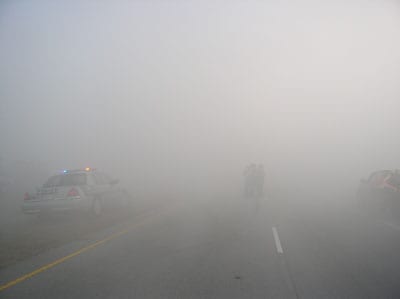 |
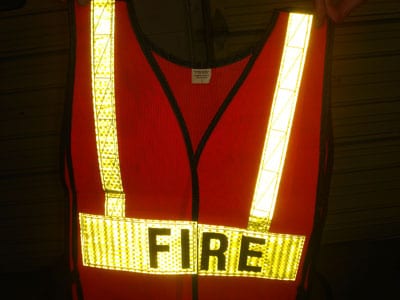 |
|
Photo 2. Highway safety vest worn by fire department personnel on scene. |
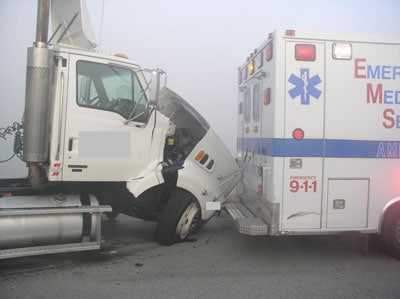 |
|
Photo 3. Final resting position of tractor-trailer. |
 |
|
Photo 4. Traffic control devices used by Unit 1911. |
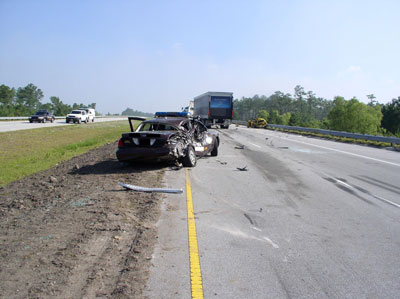 |
|
Photo 5. Crash scene looking north from northbound lanes. |
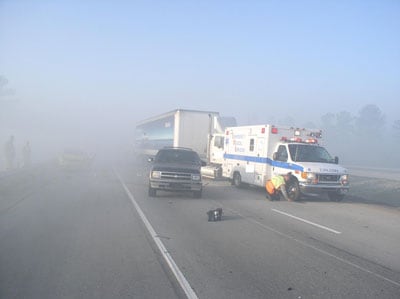 |
|
Photo 6. Crash scene looking south from northbound lanes. |
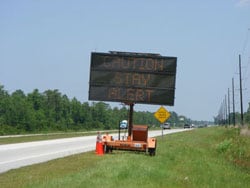 |
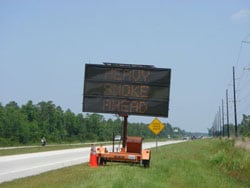 |
|
Photo 7. Portable changeable message and NCDOT signs posted immediately after the incident. |
|
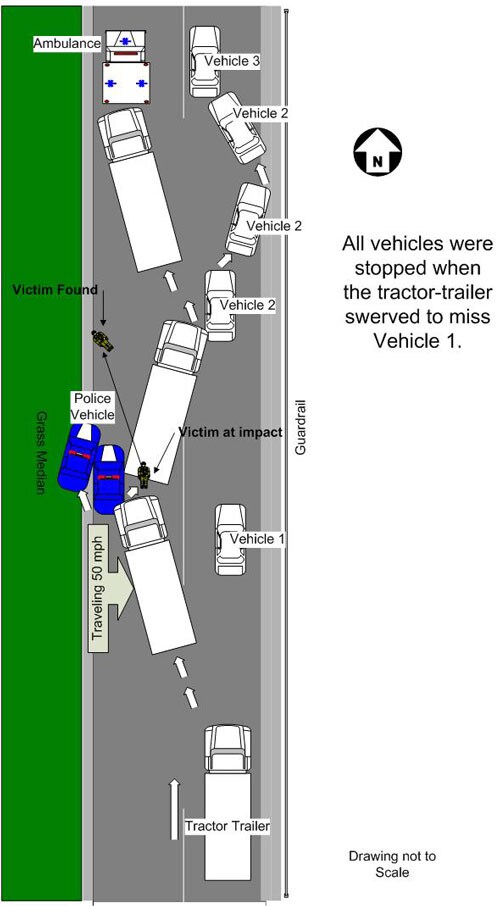 |
|
|
Diagram 1. Fatal Path |
|
This page was last updated on 12/15/08.
